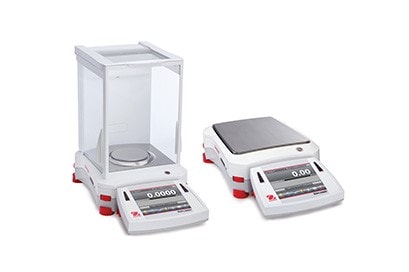Top Tips for Lab Weighing with OHAUS
Introduction
External factors such as temperature fluctuations, air currents, electromagnetic interference, and vibrations can all have an impact on the accuracy of an analytical balance. By understanding and controlling these external factors, users can ensure that their analytical balance provides reliable and accurate measurements. As such, it is important to keep the balance in a controlled environment to minimize interference.
Temperature and Humidity
Temperature and humidity are two critical environmental factors that can significantly impact the weighing results on analytical balances. Understanding how these elements affect the performance of the balance is essential for obtaining accurate and reliable measurements.
Temperature: It is important to operate analytical balances within a stable temperature range, as specified by the manufacturer, in order to minimize the effects of temperature on the weighing results. Using a temperature-controlled environment or placing the balance away from sources of heat or cold can help maintain stability and consistency in measurements.
Humidity: Inconsistencies in humidity can lead to fluctuations in readings and compromise the accuracy of measurements. High humidity will cause the weighing sample to absorb moisture and change in weight. Keeping the laboratory at a controlled humidity level and storing balances in a dry environment can help prevent humidity-related issues and ensure stable weighing results. A good suggestion for maintaining optimal temperature and humidity levels in a laboratory setting is to invest in a quality HVAC (heating, ventilation, and air conditioning) system that offers precise control over these environmental factors.
In conclusion, maintaining a constant temperature of 20˚ to 25˚C and a relative humidity (RH) level of between 40 and 55 percent in the laboratory environment is essential for optimal performance and accuracy of analytical balances. Implementing effective temperature and humidity control measures can help create a stable and controlled setting for precise weighing operations and reliable experimental outcomes.
Tip 1: Regularly monitor and track the temperature and humidity levels in the lab using dedicated monitoring devices or data loggers. This allows lab personnel to quickly identify any fluctuations or deviations from the recommended ranges and take corrective action as needed.
Tip 2: By effectively controlling the temperature and humidity in a laboratory biological safety cabinet, researchers can ensure the accuracy and reliability of their experiments, as well as preserve the integrity of their biological samples.
Air Currents
Air currents, such as from drafts or air conditioning vents, can have a significant impact on the stability and accuracy of an analytical balance. This is because airflow can create vibrations or movement in the balance, leading to instability in the load cell and thus fluctuations in weight readings.
Tip 3: To minimize the effects of airflow on an analytical balance, place the balance in a location away from windows, doors, vents, or any other sources of air movement.
Tip 4: Using a draft shield or enclosure around a balance can help to protect it from the effects of airflow. The draft shield door should be closed gently when weighing samples and an automatic door function can be used to avoid strong door closing and ensure consistent moving speed.
Magnetic Fields
Analytical balances often use an electronic magnet force restoration (MFR) load cell that is very sensitive to external magnetic fields. Stray magnetic fields can thus disrupt the electronic signals within the balance, interfering with its proper functioning and leading to fluctuations in weight readings. To prevent the effects of magnetic interference, it is important to keep the balance away from sources of such interference including electronic devices such as motors or transformers.
Tip 5: As magnetic objects cannot be placed directly on the weighing pan, it is possible to adopt a distance weighing protocol (often called "weighing below") that maintains a distance of at least 10 cm between the sample material and the load cell.
Tip 6: Strain gauge (SG) load cell technology is different to MFR load cell technology in that it is mechanical deformation that causes resistance to change. If the weighing resolution can be less than 1 mg then choosing an SG load cell balance is ideal for weighing magnetic objects.
Electrostatic Charges
Static electricity can accumulate on objects including sample materials, containers, and even the balance itself. When static charges build up they can create imbalances in the weighing system, leading to fluctuations in readings and hindering the ability of the balance to provide accurate measurements. To mitigate the impact of static electricity on the stability of an analytical balance, it is important to take preventive measures. This can include grounding all components of the weighing system, ensuring a neutral environment with proper humidity levels, using anti-static insulating materials, and eliminating sources of static buildup in the laboratory.
Tip 7: Humidifiers can be used in laboratory environments to keep the RH in the weighing room above 40 percent, which will help earth static charges and decrease excessive static electricity. Keeping the RH above 55 percent will help the laboratory environment naturalize. In addition, using an integrated ionizer device can balance the negative and positive ions on samples and containers by neutralizing the internal environment.
Tip 8: Laboratory professionals can use stainless-steel tweezers instead of rubber tweezers to reduce the risk of static charge on the sample.
Vibration
Vibration can be another factor that contributes to instability in an analytical balance. In a laboratory environment various sources of vibration, such as nearby equipment, foot traffic, or even factors external to the laboratory, can disrupt balance readings and affect the accuracy of measurements. Even the smallest of movements can make it challenging to obtain precise results on high-resolution instruments.
Tip 9: To minimize the impact of vibration the balance should be placed on a stable, level surface that can absorb vibrations, such as a vibration dampening mat. Additionally, ensuring that the balance is situated in a location away from sources of vibration and disturbance can help maintain its stability during measurements.
Heat Radiation
Heat radiation, including human body heat, can also cause instability in an analytical balance. Such temperature variations can create air currents which can disrupt the balance and introduce inconsistencies in readings.
Tip 10: To minimize the impact of heat radiation, it is important to control the temperature in the laboratory environment. Wearing laboratory coats or coats with insulating materials when around the balance can also help to protect it and maintain stable measurement conditions.
Sample Volatilization and Moisture Regain
The temperature of the sample being weighed can also be a critical factor that contributes to instability in an analytical balance. When sample temperature changes this can impact mass or density, leading to variations in the weight measured by the balance. For example, when a sample is warmer than the surrounding environment it can create convection currents or air density differences that affect the balance readings. Vice versa, if a sample is colder than the surrounding environment it may cause condensation or changes in the sample's physical properties that can influence the measurement results.
Tip 11: Allow the sample to equilibrate to the surrounding temperature before weighing. This can help reduce thermal gradients and ensure that the weight measured accurately reflects the actual mass of the sample.
Tip 12: It is important to develop the skill of quickly weighing samples that have been stored in the laboratory refrigerator. Otherwise, the original sample can easily gain moisture or evaporate.
Aerostatic Buoyancy
Air buoyancy, or the force exerted by air or gases on objects immersed in them, can also be a significant factor that contributes to instability in an analytical balance. Changes in air density, such as fluctuations in temperature or altitude, can impact the apparent weight of objects. Additionally, air currents or drafts within the laboratory environment can further disrupt the equilibrium of the balance and introduce inconsistencies in measurements.
Tip 13: Regularly calibrating a balance under specific environmental conditions can aid in compensating for the impact of air buoyancy.










